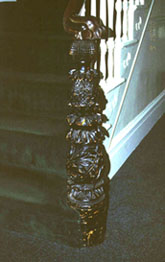

163 South Willard Street
The Winterbotham Estate
By Andrea Livi
 The
only survivor from 1830 on South Willard Street itself, the Winterbotham
estate was named for one of its later owners, a successful, cosmopolitan
businessman. Built in the 1820s by John Potwin (4),
a merchant, the house originally consisted of a two-story center
block with north and south one-story wings (5).
The wealth of the owner was expressed by the fine craftsmanship,
as is evident in the main stair newel post, shown left. Although
David Blow wrote in his book that the Winterbotham house was not
erected until 1832, this is disproved by its recognisable footprint
visible on the Young map of 1830.
The
only survivor from 1830 on South Willard Street itself, the Winterbotham
estate was named for one of its later owners, a successful, cosmopolitan
businessman. Built in the 1820s by John Potwin (4),
a merchant, the house originally consisted of a two-story center
block with north and south one-story wings (5).
The wealth of the owner was expressed by the fine craftsmanship,
as is evident in the main stair newel post, shown left. Although
David Blow wrote in his book that the Winterbotham house was not
erected until 1832, this is disproved by its recognisable footprint
visible on the Young map of 1830.
Soon after it was built, in 1833 (6), the house was sold to Don Carlos Baxter, a prominent lawyer. The house stayed in his possession for about thirty years, as maps of that time attest. He added much to the original late Federal syle structure, creating a rambling, large whole. Baxter built a second story onto the south wing, connected the carriage barn to the main house and also adding a wood-framed ballroom (7). The next owner of the house, Gustavus A. Austin, had inherited his wealth. He bought the house in 1867 (8). and kept it as the summer home for his family, who lived in New York during the winter.
The final private owner of 163 South Willard Street was Joseph Winterbotham who gave the house its name. This wealthy businessman retired in Burlington in 1925 (9), settling in the house. He continued traveling and remained active in the community until his death in 1954. At that time, the house was closed and "eventually given to the University of Vermont which in turn sold it to Burlington School Department."(10) The house was used as administrative offices and ultimately was transferred to another educational institution: Champlain College.
Today, the house is still used by Champlain College. The house remains a landmark in this area, and the interior is still very well preserved although many rooms have been subdivided for their use as administrative offices.